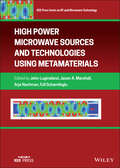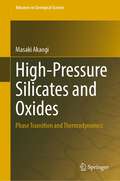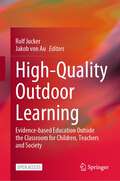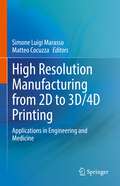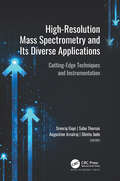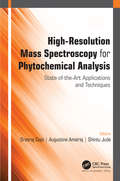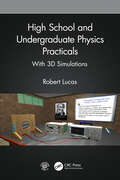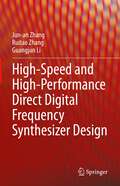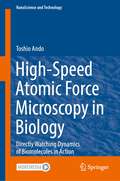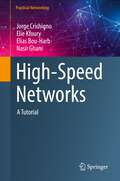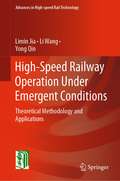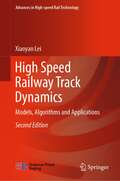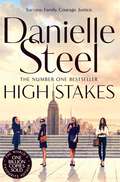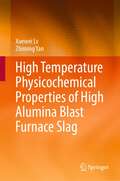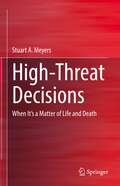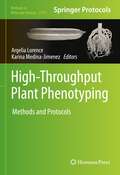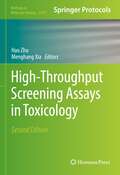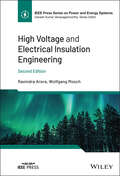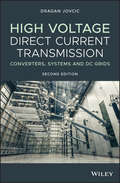- Table View
- List View
High Power Microwave Sources and Technologies Using Metamaterials (IEEE Press Series on RF and Microwave Technology)
by John W. Luginsland Jason A. Marshall Arje Nachman Edl SchamilogluExplore the latest research avenues in the field of high-power microwave sources and metamaterials A stand-alone follow-up to the highly successful High Power Microwave Sources and Technologies, the new High Power Microwave Sources and Technologies Using Metamaterials, demonstrates how metamaterials have impacted the field of high-power microwave sources and the new directions revealed by the latest research. It’s written by a distinguished team of researchers in the area who explore a new paradigm within which to consider the interaction of microwaves with material media. Providing contributions from multiple institutions that discuss theoretical concepts as well as experimental results in slow wave structure design, this edited volume also discusses how traditional periodic structures used since the 1940s and 1950s can have properties that, until recently, were attributed to double negative metamaterial structures. The book also includes: A thorough introduction to high power microwave oscillators and amplifiers, as well as how metamaterials can be introduced as slow wave structures and other components Comprehensive explorations of theoretical concepts in dispersion engineering for slow wave structure design, including multi-transmission line models and particle-in-cell code virtual prototyping models Practical discussions of experimental measurements in dispersion engineering for slow wave structure design In-depth examinations of passive and active components, as well as the temporal evolution of electromagnetic fields High Power Microwave Sources and Technologies Using Metamaterials is a perfect resource for graduate students and researchers in the areas of nuclear and plasma sciences, microwaves, and antennas.
High-Pressure Silicates and Oxides: Phase Transition and Thermodynamics (Advances in Geological Science)
by Masaki AkaogiThis book presents a summary of high-pressure phase transitions of minerals and related inorganic compounds. The first part reviews the methods to investigate phase transitions by direct high-pressure and high-temperature experiments together with thermodynamic approaches that consist of calorimetric measurements and thermodynamic calculation. In the second part, phase relations and thermodynamic properties of olivine, pyroxene, garnet, spinel, perovskite, rutile, and related inorganic compounds with A2BO4, ABO3, AB2O4, and AO2 stoichiometries are described. Particular emphasis is placed on spinel- and perovskite-structured phases and their high-pressure polymorphs called post-spinel and post-perovskite phases. The last part of the book focuses on phase relations of mantle rocks and on natural high-pressure minerals from the Earth’s deep mantle and in shocked meteorites.
High-Quality Outdoor Learning: Evidence-based Education Outside the Classroom for Children, Teachers and Society
by Rolf Jucker Jakob Von AuThis open access book reviews evidence and case studies on the effects of outdoor learning on teachers and learners. It shows how real-world learning outside the classroom contributes to unlocking the full potential of learners, demonstrating its benefits for academic learning, social competencies, personal and emotional development, psychological well-being, and physical activity and health. In addition, the book highlights how outdoor learning nurtures environmental awareness and helps learners to tackle current sustainability challenges. Its focus on high-quality learning makes it a unique contribution to the implementation of SDG 4. Aimed at lecturers at teacher training universities, teachers, professional educators, coaches, and multipliers who train staff of educational NGOs, as well as decision makers on all levels of education systems, this book is of interest to all those who seek a more in-depth understanding of the future of education.
High Resolution Manufacturing from 2D to 3D/4D Printing: Applications in Engineering and Medicine
by Simone Luigi Marasso Matteo CocuzzaThis book provides a comprehensive presentation of the most frequently used high resolution manufacturing techniques available, as well as the polymeric materials used for each of the techniques. Divided into two parts covering the technologies and materials used and the impact on different research fields and case studies, High Resolution Manufacturing from 2D to 3D/4D Printing: Applications in Engineering and Medicine addresses issues like throughput improvement by volumetric 3D printing and presenting novel applications and case studies. In addition, this book also covers the latest breakthrough developments and innovations to help readers understand the future applications of this technology across various disciplines, including biomedicine, electronics, energy, and photonics.
High-Resolution Mass Spectrometry and Its Diverse Applications: Cutting-Edge Techniques and Instrumentation
by Sreeraj Gopi Sabu Thomas Augustine Amalraj Shintu JudeThis informative book offers a wide range of knowledge on the technologies and applications of the cutting-edge field of high-resolution mass spectrometry (HRMS) in different areas of analysis. HRMS has changed the nature of experimentation and investigation in so many analytical realms. Determining exact mass determination, high resolution, and specificity—via the special features provided by HRMS instruments—is now possible for determining the composition of the analyte of interest, both qualitatively and quantitatively. High-Resolution Mass Spectrometry and Its Diverse Applications: Cutting-Edge Techniques and Instrumentation begins with an overview of the basic instrumentation techniques and goes on to present research on diverse new uses of HRMS in clinical testing, such as for therapeutic drug designing, discovery, and development; in forensic studies and investigations; in quality management systems; for analysis of pesticides; for analysis of single cells; in analysis of fossil fuels; for use in space and planetary science; and more. Chapters relay how HRMS plays an important role in the structure elucidation and unknown determination in many fields and is a great measure to be used for quantitative analyses. The book considers how these properties make the technique a strong aid in many areas. This volume highlights how HRMS can be a useful tool for scientists and researchers, faculty and students, and industry professionals in many scientific areas of study.
High-Resolution Mass Spectrometry and Its Diverse Applications: Cutting-Edge Techniques and Instrumentation
by Sreeraj Gopi Sabu Thomas Augustine Amalraj Shintu JudeThis informative book offers a wide range of knowledge on the technologies and applications of the cutting-edge field of high-resolution mass spectrometry (HRMS) in different areas of analysis. HRMS has changed the nature of experimentation and investigation in so many analytical realms. Determining exact mass determination, high resolution, and specificity—via the special features provided by HRMS instruments—is now possible for determining the composition of the analyte of interest, both qualitatively and quantitatively. High-Resolution Mass Spectrometry and Its Diverse Applications: Cutting-Edge Techniques and Instrumentation begins with an overview of the basic instrumentation techniques and goes on to present research on diverse new uses of HRMS in clinical testing, such as for therapeutic drug designing, discovery, and development; in forensic studies and investigations; in quality management systems; for analysis of pesticides; for analysis of single cells; in analysis of fossil fuels; for use in space and planetary science; and more. Chapters relay how HRMS plays an important role in the structure elucidation and unknown determination in many fields and is a great measure to be used for quantitative analyses. The book considers how these properties make the technique a strong aid in many areas. This volume highlights how HRMS can be a useful tool for scientists and researchers, faculty and students, and industry professionals in many scientific areas of study.
High-Resolution Mass Spectroscopy for Phytochemical Analysis: State-of-the-Art Applications and Techniques
by Sreeraj Gopi Augustine Amalraj Shintu JudeThis new volume provides a bird’s-eye view of the properties, utilization, and importance of high resolution mass spectrometry (HRMS) for phytochemical analysis. The book discusses the new and state-of-the-art technologies related to HRMS in phytochemical analysis for the food industry in a comprehensive manner. Phytochemical characterization of plants is important in the food and nutraceutical industries and is also necessary in the procedures followed for drug development, toxicology determination, forensic studies, origin verification, quality assurance, etc. Easy determination of active compounds and isolation as well as purification of the same from natural matrices are required, and the possibilities and advantages of HRMS pave the way for improved analysis patterns in phytochemistry. This book is unique in that its sole consideration is on the importance of HRMS in the field of phytochemical analysis. Along with an overview of basic instrumental information, the volume provides a detailed account of data processing and dereplication strategies. Technologies such as bioanalytical techniques and bioassays are considered also to provide support for the functions of the instruments used. In addition, a case study is presented to depict the complete phytochemical characterization of a matrix by HRMS. The book covers processing and computational techniques, dereplication, hyphenation, high-resolution bioassays, bioanalytical screening/purification techniques, applications of gas chromatography–high-resolution mass spectrometry, and more. Key features: Covers the fundamental instrumentation and techniques Discusses HRMS-based phytochemical research details Focuses strictly on the phytochemical considerations High-Resolution Mass Spectroscopy for Phytochemical Analysis: State-of-the-Art Applications and Techniques will be a valuable reference guide and resource for researchers, faculty and students in related fields, as well as those in the phytochemical industries.
High-Resolution Mass Spectroscopy for Phytochemical Analysis: State-of-the-Art Applications and Techniques
by Sreeraj GopiThis new volume provides a bird’s-eye view of the properties, utilization, and importance of high resolution mass spectrometry (HRMS) for phytochemical analysis. The book discusses the new and state-of-the-art technologies related to HRMS in phytochemical analysis for the food industry in a comprehensive manner. Phytochemical characterization of plants is important in the food and nutraceutical industries and is also necessary in the procedures followed for drug development, toxicology determination, forensic studies, origin verification, quality assurance, etc. Easy determination of active compounds and isolation as well as purification of the same from natural matrices are required, and the possibilities and advantages of HRMS pave the way for improved analysis patterns in phytochemistry. This book is unique in that its sole consideration is on the importance of HRMS in the field of phytochemical analysis. Along with an overview of basic instrumental information, the volume provides a detailed account of data processing and dereplication strategies. Technologies such as bioanalytical techniques and bioassays are considered also to provide support for the functions of the instruments used. In addition, a case study is presented to depict the complete phytochemical characterization of a matrix by HRMS. The book covers processing and computational techniques, dereplication, hyphenation, high-resolution bioassays, bioanalytical screening/purification techniques, applications of gas chromatography–high-resolution mass spectrometry, and more. Key features: Covers the fundamental instrumentation and techniques Discusses HRMS-based phytochemical research details Focuses strictly on the phytochemical considerations High-Resolution Mass Spectroscopy for Phytochemical Analysis: State-of-the-Art Applications and Techniques will be a valuable reference guide and resource for researchers, faculty and students in related fields, as well as those in the phytochemical industries.
High School and Undergraduate Physics Practicals: With 3D Simulations
by Robert LucasThis book describes more than thirty physics practicals at high school and undergraduate levels with background information on each one, a description of the equipment needed, and instructions on how the experiment is performed. Uniquely, for those without access to a real laboratory, the book provides access to highly detailed 3D simulations of all the experiments. The simulations are a superset of the Virtual Physics Laboratory as reviewed and given the Green Tick of Approval by the Association for Science Education. They run in any browser that supports WebGL, such as Microsoft Edge or Firefox on Windows and Safari on Mac. For the school or university student who wants to practice and widen their knowledge of physics, or for those who are learning on their own, this is an ideal book for honing and broadening experimental skills. The simulations are the result of many years researching the teaching of online science, a field in which the author has published many papers.
High School and Undergraduate Physics Practicals: With 3D Simulations
by Robert LucasThis book describes more than thirty physics practicals at high school and undergraduate levels with background information on each one, a description of the equipment needed, and instructions on how the experiment is performed. Uniquely, for those without access to a real laboratory, the book provides access to highly detailed 3D simulations of all the experiments. The simulations are a superset of the Virtual Physics Laboratory as reviewed and given the Green Tick of Approval by the Association for Science Education. They run in any browser that supports WebGL, such as Microsoft Edge or Firefox on Windows and Safari on Mac. For the school or university student who wants to practice and widen their knowledge of physics, or for those who are learning on their own, this is an ideal book for honing and broadening experimental skills. The simulations are the result of many years researching the teaching of online science, a field in which the author has published many papers.
The High Sierra: A Love Story
by Kim Stanley RobinsonA &“sublime&” and &“radically original&” exploration of the Sierra Nevadas, the best mountains on Earth for hiking and camping, from New York Times bestselling novelist Kim Stanley Robinson (Bill McKibben, Gary Snyder). Kim Stanley Robinson first ventured into the Sierra Nevada mountains during the summer of 1973. He returned from that encounter a changed man, awed by a landscape that made him feel as if he were simultaneously strolling through an art museum and scrambling on a jungle gym like an energized child. He has returned to the mountains throughout his life—more than a hundred trips—and has gathered a vast store of knowledge about them. The High Sierra is his lavish celebration of this exceptional place and an exploration of what makes this span of mountains one of the most compelling places on Earth.Over the course of a vivid and dramatic narrative, Robinson describes the geological forces that shaped the Sierras and the history of its exploration, going back to the indigenous peoples who made it home and whose traces can still be found today. He celebrates the people whose ideas and actions protected the High Sierra for future generations. He describes uniquely beautiful hikes and the trails to be avoided. Robinson&’s own life-altering events, defining relationships, and unforgettable adventures form the narrative&’s spine. And he illuminates the human communion with the wild and with the sublime, including the personal growth that only seems to come from time spent outdoors.The High Sierra is a gorgeous, absorbing immersion in a place, born out of a desire to understand and share one of the greatest rapture-inducing experiences our planet offers. Packed with maps, gear advice, more than 100 breathtaking photos, and much more, it will inspire veteran hikers, casual walkers, and travel readers to prepare for a magnificent adventure.
The High Sierra: A Love Story
by Kim Stanley RobinsonA &“sublime&” and &“radically original&” exploration of the Sierra Nevadas, the best mountains on Earth for hiking and camping, from New York Times bestselling novelist Kim Stanley Robinson (Bill McKibben, Gary Snyder). Kim Stanley Robinson first ventured into the Sierra Nevada mountains during the summer of 1973. He returned from that encounter a changed man, awed by a landscape that made him feel as if he were simultaneously strolling through an art museum and scrambling on a jungle gym like an energized child. He has returned to the mountains throughout his life—more than a hundred trips—and has gathered a vast store of knowledge about them. The High Sierra is his lavish celebration of this exceptional place and an exploration of what makes this span of mountains one of the most compelling places on Earth.Over the course of a vivid and dramatic narrative, Robinson describes the geological forces that shaped the Sierras and the history of its exploration, going back to the indigenous peoples who made it home and whose traces can still be found today. He celebrates the people whose ideas and actions protected the High Sierra for future generations. He describes uniquely beautiful hikes and the trails to be avoided. Robinson&’s own life-altering events, defining relationships, and unforgettable adventures form the narrative&’s spine. And he illuminates the human communion with the wild and with the sublime, including the personal growth that only seems to come from time spent outdoors.The High Sierra is a gorgeous, absorbing immersion in a place, born out of a desire to understand and share one of the greatest rapture-inducing experiences our planet offers. Packed with maps, gear advice, more than 100 breathtaking photos, and much more, it will inspire veteran hikers, casual walkers, and travel readers to prepare for a magnificent adventure.
High-Speed and High-Performance Direct Digital Frequency Synthesizer Design
by Jun-an Zhang Ruitao Zhang Guangjun LiThe book focuses on design technology of high-speed and high-performance direct digital frequency synthesizer (DDS) chip. The technologies involves phase to amplitude converter design, D/A converter design, phase accumulator design, multi-chip synchronization circuit design, etc. In each chapter, the concept of the technology is explained first, and then the features of different implementation schemes are introduced through the real design cases. More over, a design case of a 2.5GHz monolithic DDS in 0.18 μm CMOS which was designed by the authors are introduced in detail, which can help the reader understanding about the of DDS design deeply. The book is suitable for the readers who are interested to learn practical design technology in DDS. The book can benefit researchers, engineers, and graduate students in fields of mix-signal IC design, communication engineering, electronics engineering, and radar engineering, etc.
High-Speed Atomic Force Microscopy in Biology: Directly Watching Dynamics of Biomolecules in Action (NanoScience and Technology)
by Toshio AndoThis first book on high-speed atomic force microscopy (HS-AFM) is intended for students and biologists who want to use HS-AFM in their research. It provides straightforward explanations of the principle and techniques of AFM and HS-AFM. Numerous examples of HS-AFM studies on proteins demonstrate how to apply this new form of microscopy to specific biological problems. Several precautions for successful imaging and the preparation of cantilever tips and substrate surfaces will greatly benefit first-time users of HS-AFM. In turn, the instrumentation techniques detailed in Chapter 4 can be skipped, but will be useful for engineers and scientists who want to develop the next generation of high-speed scanning probe microscopes for biology.The book is intended to facilitate the first-time use of this new technique, and to inspire students and researchers to tackle their own specific biological problems by directly observing dynamic events occurring in the nanoscopic world. Microscopy in biology has recently entered a new era with the advent of high-speed atomic force microscopy (HS-AFM). Unlike optical microscopy, electron microscopy, and conventional slow AFM, it allows us to directly observe biological molecules in physiological environments. Molecular “movies” created using HS-AFM can directly reveal how molecules behave and operate, without the need for subsequent complex analyses and roundabout interpretations. It also allows us to directly monitor morphological change in live cells, and dynamic molecular events occurring on the surfaces of living bacteria and intracellular organelles. As HS-AFM instruments were recently commercialized, in the near future HS-AFM is expected to become a common tool in biology, and will enhance and accelerate our understanding of biological phenomena.
High-Speed Networks: A Tutorial (Practical Networking)
by Jorge Crichigno Elie Kfoury Elias Bou-Harb Nasir GhaniThis book provides practical knowledge and skills on high-speed networks, emphasizing on Science Demilitarized Zones (Science DMZs). The Science DMZ is a high-speed network designed to facilitate the transfer of big science data which is presented in this book. These networks are increasingly important, as large data sets are now often transferred across sites. This book starts by describing the limitations of general-purpose networks which are designed for transferring basic data but face numerous challenges when transferring terabyte- and petabyte-scale data. This book follows a bottom-up approach by presenting an overview of Science DMZs and how they overcome the limitations of general-purpose networks. It also covers topics that have considerable impact on the performance of large data transfers at all layers: link layer (layer-2) and network layer (layer-3) topics such as maximum transmission unit (MTU), switch architectures, and router’s buffer size; transport layer (layer-4) topics including TCP features, congestion control algorithms for high-throughput high-latency networks, flow control, and pacing; applications (layer-5) used for large data transfers and for maintenance and operation of Science DMZs; and security considerations. Most chapters incorporate virtual laboratory experiments, which are conducted using network appliances running real protocol stacks. Students in computer science, information technology and similar programs, who are interested in learning fundamental concepts related to high-speed networks and corresponding implementations will find this book useful as a textbook. This book assumes minimal familiarity with networking, typically covered in an introductory networking course. It is appropriate for an upper-level undergraduate course and for a first-year graduate course. Industry professionals working in this field will also want to purchase this book.
High-Speed Railway Operation Under Emergent Conditions: Theoretical Methodology and Applications (Advances in High-speed Rail Technology)
by Limin Jia Li Wang Yong QinThis book addresses the current development status of high-speed railways globally and analyzes their operational schemes and practices under emergent conditions. It covers methods and problem-solving philosophy with regard to complexity analysis, capacity evaluation, passenger-flow forecasts, operating strategies, passenger-flow allocation, resource allocation and supporting technologies in the context of serious accidents and adverse environmental influences on train operation and service organization of high-speed railways. The abnormal scenarios, emergent conditions, adverse events and corresponding theoretical and applicational solutions dealing with the train operation both in line and network scale are all from real-world cases related to and designed for Chinese high-speed railway network which is the largest in scale, the highest in complexity and the most difficult in tackling with the complex and diverse climate and geographical environment , and thus makes the book both theoretically rigorous and practically applicable. It not only helps readers consider the train and network interactions from the perspective of complexity science, but also provides them with a philosophical framework and approaches available to construct their own roadmap and problem-solving paradigms in their daily research or management. This book is suitable for researchers, postgraduates and managerial and engineering practitioners in railway-related fields, especially in high-speed railway operation and emergency management.
High Speed Railway Track Dynamics: Models, Algorithms and Applications (Advances in High-speed Rail Technology)
by Xiaoyan LeiThe second edition of this book systematically summarizes the latest research findings on high-speed railway track dynamics, made by the author and his research team over the past decade. It explores cutting-edge issues concerning the basic theory of high-speed railways, covering the dynamic theories, models, algorithms and engineering applications of the high-speed train and track coupling system. Presenting original concepts, systematic theories and advanced algorithms, the book places great emphasis on the precision and completeness of its content. The chapters are interrelated yet largely self-contained, allowing readers to either read through the book as a whole or focus on specific topics. It also combines theories with practice to effectively introduce readers to the latest research findings and developments in high-speed railway track dynamics. It offers a valuable resource for researchers, postgraduates and engineers in the fields of civil engineering, transportation, highway and railway engineering.
High Stakes
by Danielle SteelA compelling and thought-provoking novel from the world’s favourite storyteller. Set around a New York talent agency, a group of accomplished women discover the high price of success. Jane Addison is smart, young and ambitious. She’s delighted to have landed a job with a prestigious talent agency, Fletcher and Benson. Hailey West, her boss, is dedicated to her authors, but her home life is chaotic and challenging as a single mother following her husband’s tragic death. Francine Rivers, the stern and bitter head of department, is also raising children on her own after an acrimonious divorce, and she has had to overcome financial hardship by paying the very highest price. Meanwhile, Allie Moore seems to have it all: she relishes success and loves working with the talented actors she represents. But then a passionate relationship with one of her star clients risks derailing her career. And Merriwether Jones, the CFO of the agency, appears to have the perfect marriage until her husband’s jealousy over her career threatens her happiness. Jane quickly realizes that there are damaging secrets behind the doors of the agency. She has the least power, but she is also the least willing to accept things as they are. And when she tries to put things right, the consequences will leave no one unscathed. In this riveting novel, five women at the top of their game navigate the challenges of career and ambition, family and personal lives in a world where it’s necessary to fight for what is right.
High Temperature Physicochemical Properties of High Alumina Blast Furnace Slag
by Xuewei Lv Zhiming YanThis book presents the physicochemical properties and structure of high-alumina slag in the ironmaking process. The book consists of seven chapters demonstrating the effect of Al2O3 on the properties and structure of slag. Based on experimental research and practical requirements, a revolutionary technical route for blast furnace smelting of high-alumina iron ore is proposed. The book presents the scientific basis and offers theoretical guidance for the large-scale utilization of high-alumina iron ore in ironmaking process. Therefore, it is of interest for not only academic researchers but also practitioners in this field.
High-Threat Decisions: When It’s a Matter of Life and Death
by Stuart MeyersHigh-threat decision-making is intrinsic to many domains and carries an individual, organizational, and social responsibility. Tactical and incident commanders make decisions in the high-threat law enforcement context of hostage rescue, armed barricaded suspects, and armed suicidal individuals that can result in successful or catastrophic outcomes. This book describes the experiences and methods of making decisions in these types of extreme environments. The presented research addresses learning strategies that could better prepare leaders for information processing in any high-threat domain, while optimizing speed and accuracy in decision-making. This volume emphasizes the role of adaptive expertise in decision-making, and explains how mental models of recurring patterns are created and retrieved, and why they are necessary for effective situational assessments. This book is ideal for police commanders and executives, emergency response managers, first responders, and criminology researchers. It is also well-suited for professionals seeking further information about improved high-threat decision-making strategies.
High-Throughput Plant Phenotyping: Methods and Protocols (Methods in Molecular Biology #2539)
by Argelia Lorence Karina Medina-JimenezThis volume looks at a collection of the latest techniques used to quantify the genome-by-environment-by-management (GxExM) interactions in a variety of model and plant crops. The chapters in this book are organized into five parts. Part One discusses high-throughput plant phenotyping (HTPP) protocols for plants growing under controlled conditions. Part Two present novel algorithms for extracting data from seed images, color analysis from fruits, and other digital readouts from 2D objects. Part Three covers molecular imaging protocols using PET and X-ray approaches, and Part Four presents a collection of HTPP techniques for crops growing under field conditions. The last part focuses on molecular analysis, metabolomics, network analysis, and statistical methods for the quantitative genetic analysis of HTP data. Written in the highly successful Methods in Molecular Biology series format, chapters include introductions to their respective topics, lists of the necessary materials and reagents, step-by-step, readily reproducible laboratory protocols, and tips on troubleshooting and avoiding known pitfalls. Cutting-edge and practical, High-Throughput Plant Phenotyping: Review and Protocols is a valuable resource for both novice and expert researchers looking to learn more about this important field.Chapter 21 is available open access under a Creative Commons Attribution 4.0 International License via link.springer.com.
High-Throughput Screening Assays in Toxicology (Methods in Molecular Biology #2474)
by Hao Zhu Menghang XiaThis second edition volume expands on the previous edition by exploring the latest advancements in high throughput screening (HTS) in toxicity studies by using in vitro, ex vivo, and in vivo models. This volume also covers the application of artificial intelligence (AI) and data science to curate, manage, and use HTS data. Written in the highly successful Methods in Molecular Biology series format, chapters include introductions to their respective topics, lists of the necessary materials and reagents, step-by-step, readily reproducible laboratory protocols, and tips on troubleshooting and avoiding known pitfalls. Cutting-edge and thorough, High Throughput Screening Assays in Modern Toxicology, Second Edition is a valuable resource for scientists pursuing chemical toxicology research. This book will aid scientists and researchers in translating new HTS techniques into standardized chemical toxicology assessment tools that can refine, reduce, and replace animal testing.
High Voltage and Electrical Insulation Engineering (IEEE Press Series on Power and Energy Systems)
by Ravindra Arora Wolfgang MoschHigh Voltage and Electrical Insulation Engineering A comprehensive graduate-level textbook on high voltage insulation engineering, updated to reflect emerging trends and techniques in the field High Voltage and Electrical Insulation Engineering presents systematic coverage of the behavior of dielectric materials. This classic textbook opens with clear explanations of fundamental terminology, electric-field classification, and field estimation techniques. Subsequent chapters describe the field dependent performance of gaseous, vacuum, liquid, and solid dielectrics under different classified field conditions, and illustrate the monitoring of electrical insulation conditions by both single and continuous online methods. Throughout the text, numerous tables, figures, diagrams, and images are provided to strengthen understanding of all material. Fully revised to incorporate the most current technological application techniques, the second edition offers an entirely new section on condition monitoring of electrical insulation. Updated chapters discuss recent developments in gas-filled power apparatus, present-day trends in the use replacement of liquid insulating materials, the latest applications of new solid dielectrics in high voltage engineering, vacuum technology and liquid insulating materials, and more. This edition features a brand-new case study exploring the estimation of clearance requirements for 25 kV electric traction. Readers will also find the new edition: Provides new coverage of advances in the field, such as the application of polymer insulators and the use of SF6 gas and its mixtures in gas-insulated systems/substations (GIS) Uses a novel approach that explores the field dependent behavior of dielectrics Explains the “weakly nonuniform field,” a unique concept introduced both conceptually and analytically in Germany A separate chapter provides the new approach to the mechanism of lightning phenomenon, which also includes the phenomenon of “Ball Lightning” The dielectric properties of vacuum and the development in the application of vacuum technology in power circuit breakers is covered in an exclusive chapter In-depth coverage of the performance of the sulphur-hexafluoride gas and its mixtures applicable to the design of Gas Insulated Systems including dry power transformers High Voltage and Electrical Insulation Engineering, Second Edition, remains the perfect textbook for graduate students, teachers, academic researchers, and utility and power industry engineers and scientists involved in the field.</p.
High Voltage and Electrical Insulation Engineering (IEEE Press Series on Power and Energy Systems #69)
by Ravindra Arora Wolfgang MoschHigh Voltage and Electrical Insulation Engineering A comprehensive graduate-level textbook on high voltage insulation engineering, updated to reflect emerging trends and techniques in the field High Voltage and Electrical Insulation Engineering presents systematic coverage of the behavior of dielectric materials. This classic textbook opens with clear explanations of fundamental terminology, electric-field classification, and field estimation techniques. Subsequent chapters describe the field dependent performance of gaseous, vacuum, liquid, and solid dielectrics under different classified field conditions, and illustrate the monitoring of electrical insulation conditions by both single and continuous online methods. Throughout the text, numerous tables, figures, diagrams, and images are provided to strengthen understanding of all material. Fully revised to incorporate the most current technological application techniques, the second edition offers an entirely new section on condition monitoring of electrical insulation. Updated chapters discuss recent developments in gas-filled power apparatus, present-day trends in the use replacement of liquid insulating materials, the latest applications of new solid dielectrics in high voltage engineering, vacuum technology and liquid insulating materials, and more. This edition features a brand-new case study exploring the estimation of clearance requirements for 25 kV electric traction. Readers will also find the new edition: Provides new coverage of advances in the field, such as the application of polymer insulators and the use of SF6 gas and its mixtures in gas-insulated systems/substations (GIS) Uses a novel approach that explores the field dependent behavior of dielectrics Explains the “weakly nonuniform field,” a unique concept introduced both conceptually and analytically in Germany A separate chapter provides the new approach to the mechanism of lightning phenomenon, which also includes the phenomenon of “Ball Lightning” The dielectric properties of vacuum and the development in the application of vacuum technology in power circuit breakers is covered in an exclusive chapter In-depth coverage of the performance of the sulphur-hexafluoride gas and its mixtures applicable to the design of Gas Insulated Systems including dry power transformers High Voltage and Electrical Insulation Engineering, Second Edition, remains the perfect textbook for graduate students, teachers, academic researchers, and utility and power industry engineers and scientists involved in the field.</p.
High Voltage Direct Current Transmission: Converters, Systems and DC Grids
by Dragan JovcicPresents the latest developments in switchgear and DC/DC converters for DC grids, and includes substantially expanded material on MMC HVDC This newly updated edition covers all HVDC transmission technologies including Line Commutated Converter (LCC) HVDC; Voltage Source Converter (VSC) HVDC, and the latest VSC HVDC based on Modular Multilevel Converters (MMC), as well as the principles of building DC transmission grids. Featuring new material throughout, High Voltage Direct Current Transmission: Converters, Systems and DC Grids, 2nd Edition offers several new chapters/sections including one on the newest MMC converters. It also provides extended coverage of switchgear, DC grid protection and DC/DC converters following the latest developments on the market and in research projects. All three HVDC technologies are studied in a wide range of topics, including: the basic converter operating principles; calculation of losses; system modelling, including dynamic modelling; system control; HVDC protection, including AC and DC fault studies; and integration with AC systems and fundamental frequency analysis. The text includes: A chapter dedicated to hybrid and mechanical DC circuit breakers Half bridge and full bridge MMC: modelling, control, start-up and fault management A chapter dedicated to unbalanced operation and control of MMC HVDC The advancement of protection methods for DC grids Wideband and high-order modeling of DC cables Novel treatment of topics not found in similar books, including SimPowerSystems models and examples for all HVDC topologies hosted by the 1st edition companion site. High Voltage Direct Current Transmission: Converters, Systems and DC Grids, 2nd Edition serves as an ideal textbook for a graduate-level course or a professional development course.
